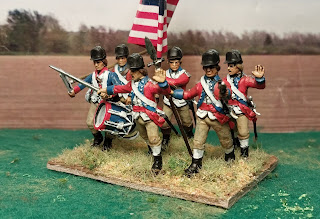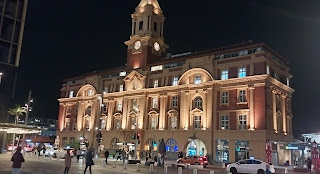The Additional Continental regiments differ from all other Continental Army infantry regiments by the manner in which they formed.
The 16 Additional Continental regiments were approved by Congress as a separate group on December 27, 1776, specifically in response to a request from Gen. George Washington for additional troops, and Congress expressly delegated their formation directly to Washington.
All Additional Continental regiments were organized in the spring and summer of 1777. In contrast to both the Extra and Additional regiments, all other infantry regiments of the army were organized and supported under the direct authority of individual state governments.
The 16 Additional Continental regiments formed later and under distinctly different circumstances than those of the Extra Continental regiments.
The 1-year enlistments in most Continental Army regiments that formed in the earliest part of the American Revolutionary War expired on December 31, 1776. Therefore, Congress and Washington began preparations for reorganizing the army during that early fall.
The reorganization was to apply to troops from every state, and a major factor in the new plan was the decision to recruit for the duration of the war rather than for a single year.
Eighty-eight regiments were authorized by a Congressional resolve of September 16, 1776, in which Congress formally outlined the 13 state lines of the Continental Army by specifying the quota of regiments for each state.
Congress' estimates of the population of each state governed its allocation of regiments, ranging from 15 regiments each from Massachusetts and Virginia to single regiments from Delaware and Georgia. In correspondence to Congress during December 1776, however, Washington pressed for even more men.
Central to Washington's position was a recommendation to increase the infantry regiments from the 88 called for in September to a minimum of 110.
In contrast to the previously approved 88 regiments, the 16 Additional regiments were organized directly by Washington's authority, rather than by the authority of the state governments, and were placed completely under Washington's control.
The resolution gave Washington the requested 110 regiments, for in addition to the 16 new regiments and the 88 units of the September quotas there were the 6 Extra regiments that had been previously approved by Congress and that were also not explicitly tied to a single state.
Units designated "Additional Continental Regiments" were unnumbered infantry regiments authorized in 1777. These units were raised "at large" and not part of any state's quota, although some were later adopted into state lines. Sixteen regiments were authorized, but because of manpower shortages Washington attempted to raise only 15.
Two of these 15 (Cornell's and Scammell's Regiments) were never organized because their colonels declined the position in favour of other commands, leaving 13 "additional" regiments. Although Washington wrote to Col. Ezekiel Cornell of Rhode Island and Col. Alexander Scammell of New Hampshire on January 12, 1777, and offered each command of one of the 16 Additional Continental regiments, both declined, and the units never raised.
Congress subsequently authorized one more "additional" regiment, Sheppard's Additional Continental Regiment, but it was absorbed into the weak North Carolina line within a year. The 16 Additional Continental regiments are:
Cornell's Continental Regiment (never formed)
Forman's Continental Regiment
Gist's Continental Regiment
Grayson's Continental Regiment
Hartley's Continental Regiment
Henley's Continental Regiment
Jackson's Continental Regiment
Lee's Continental Regiment
Malcolm's Continental Regiment
Patton's Continental Regiment
Sheppard's Continental Regiment
Sherburne's Continental Regiment
Spencer's Continental Regiment
Scammell's Continental Regiment (never formed)
Thruston's Continental Regiment
Webb's Continental Regiment
Formans Additional Continental Regiment
Henley's Additional Continental Regiment
Authorized on January 12, 1777 in the Continental Army as Henley's Additional Continental Regiment.
Assigned on May 23, 1777 to the Eastern Department
Organized in spring and summer 1777 at Boston to consist of 5 companies from Middlesex, Essex, Suffolk, and Worcester Counties, Massachusetts and Hillsborough and Rockingham Counties, New Hampshire.
Reassigned on March 18, 1778 from the Eastern Department and assigned to the Main Continental Army.
Reassigned on July 22, 1778 from the Main Army and assigned to the Eastern Department.
Consolidated on April 9, 1779 with Henry Jackson's Additional Continental Regiment.
Significant Campaigns and Battles
The regiment would see action during the New York and New Jersey Campaign (1776-77) and the Philadelphia Campaign 1777-78. It took part in the following major battles:
Battle of Rhode Island (1778)
Battle of Monmouth (1778)
Colonel David Henley himself seems to have been quite a character. Born in 1749, he served on the staffs of General William Heath and Lord Stirling before being charged with forming his regiment. In November 1778 he was appointed as Washington's Chief Intelligence Officer and set to work devising a system of recording intelligence in a meaningful and constructive way.
Right, after all that - here are a few pictures! Uniforms based again on the illustration in the free uniform info that comes with the Perry plastic box set.



















































